What Is a Cup?
A cup is a unit of volume measurement of volume equal to 16 tablespoons, $\frac{1}{2}$ pint, $\frac{1}{4}$ quart, or 8 fluid ounces.
It is used in cooking to measure liquids and powdery substances.
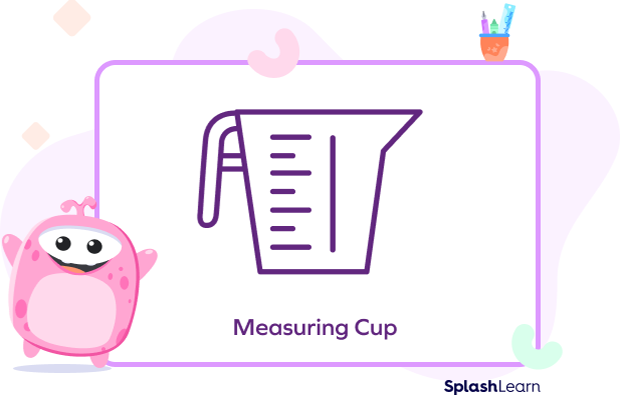
Recommended Games
Cup Definition
A cup is a customary unit used to measure volume. The U.S. measurement units for capacity or volume includes ounces, cups, pints, quarts, and gallons.
1 cup $= 16$ tablespoons $= \frac{1}{2}$ pint $= \frac{1}{4}$ quart $= 8$ fluid ounces.
Cup measurements are commonly associated with cooking or serving. A measuring cup generally measures liquids such as milk, water, oil, etc., and powdered substances such as sugar, flour, baking soda, etc. Based on these two types of measurements, it is respectively divided into:
- Liquid measuring cup
- Dry measuring cup
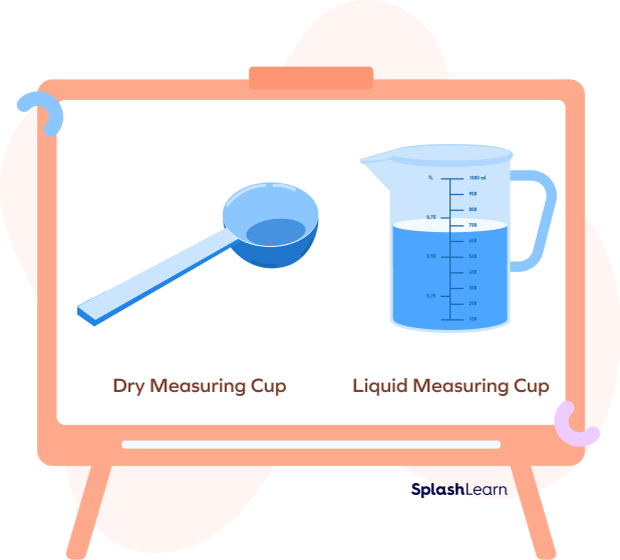
Recommended Worksheets
How to Measure Using a Cup?
There are various scale markings on a measuring cup at different heights. They help in cup measurement. The substance to be measured is poured into the cup until the required level is reached. There are different measuring cup sizes. A standard set includes $\frac{1}{4}$ cup, $\frac{1}{3}$ cup, $\frac{1}{2}$ cup and 1 cup.
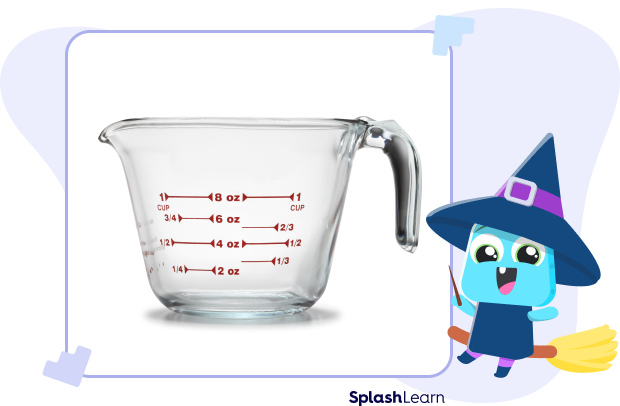
Generally, fluid ounces and pints are considered the two standard units of measurement for measuring cups. If the liquid reaches the height of 6, then there are 6 oz or $\frac{3}{4}$ cup of liquid. We can find fractions of a cup between two numbers.
Cups, Tablespoons, Teaspoons
Cups can also be measured with the help of tablespoons and teaspoons, both are much smaller units of volume. 1 tablespoon is equal to 3 teaspoons.
Note that
1 tablespoon $= 3$ teaspoons
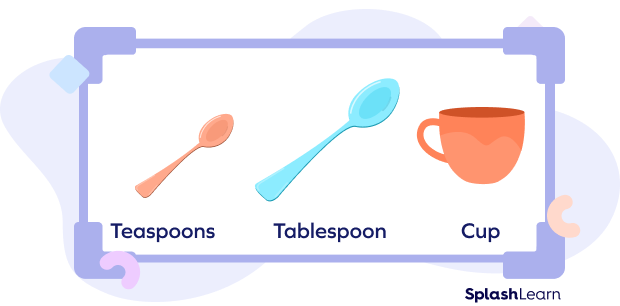
Let’s understand the cup-teaspoon-tablespoon relationship using the following image.
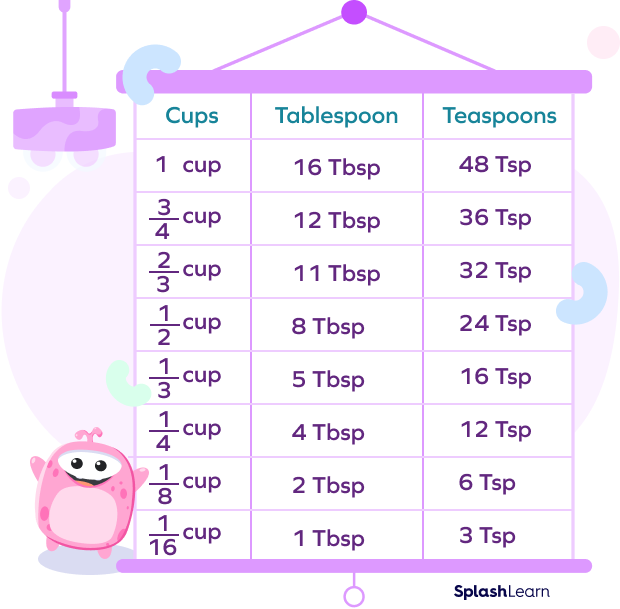
Cups, Milliliters, Ounces, Pints
A metric cup is a bit different than a US cup. 1 Cup is equal to 8 fluid ounces in US Standard Volume.1 metric cup is 250 milliliters (which is about 8.5 fluid ounces). A US cup is about 237-240 mL. The following table shows the relationship between cups, milliliters, fluid ounces, pints, and tablespoons.
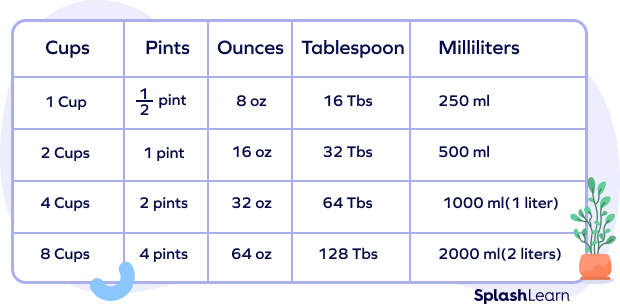
How to Make $\frac{3}{4}$ Cup with Measuring Cups?
Usually, the measuring cup sizes which are common to find are 1 cup, $\frac{1}{2}$ cup, $\frac{1}{3}$ cup, and $\frac{1}{4}$ cup. It is challenging to find a $\frac{3}{4}$ cup since measuring sets rarely have a cup that is $\frac{3}{4}$th of a cup in size.
So, to make $\frac{3}{4}$ cups, you will need to add $\frac{1}{4}$ cups three times, as shown below:
$\frac{1}{4} + \frac{1}{4} + \frac{1}{4} = \frac{3}{4}$
If you are also wondering how to measure $\frac{1}{2}$ cup, $\frac{1}{4}$ cup and $\frac{3}{4}$ cup using tablespoons, let’s revise again using a well-illustrated image!
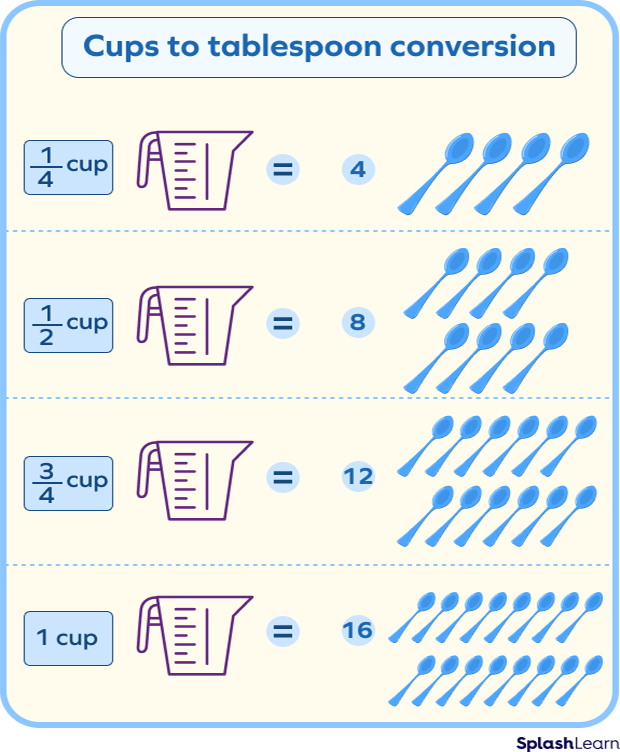
How to Measure a Cup of Water without Using a Measuring Cup?
You can measure a cup of water even if you don’t have a measuring cup. Using an object as a reference point is very helpful to measure water in the absence of a measuring cup. Having some visual images in our mind can help us remember the water amount to be measured.
Here are some instances typically used as a guide when the required tools or measuring cups are not available:
- A teaspoon: size of a finger’s tip from the joint, approximately
A tablespoon: an ice cube’s size, approximately
- $\frac{1}{4}$ cup: one large egg’s size, approximately
- $\frac{1}{2}$ cup: a tennis ball’s size approximately
- 1 cup: an apple’s size, approximately
Fun Facts!
- When translating recipes from American to British, variations are present in liquid measurement values.
- If you use a cup to measure all the ingredients, you will notice that every time the cup weighs differently depending on the ingredient’s density.
- A variety of measuring cups and spoons are required when baking and cooking. The culinary industry does not, however, have a set size requirement.
Conclusion
A measuring cup is of two types, namely, liquid and dry measuring cup. The former helps measure the volume of liquid-based things like water, milk, oil, etc., with the help of scale markings. The latter helps measure the quantity of powdered materials like sugar, baking soda, flour, etc.
Knowing how to measure a cup is imperative as it helps in measuring several things in the kitchen for cooking and outside the kitchen as well.
Solved Examples
1. Lilly wants to bake a cake. She knows she will have to add 1 cup of sugar, but she only has tablespoons available. How many tablespoons of sugar equal 1 cup?
Solution:
We know that 1 cup $= 16$ tablespoons.
So, Lilly will have to pour in the sugar 16 times using the tablespoons to equal 1 cup.
2. How many teaspoons will make $\frac{3}{4}$ cups of oil?
Solution:
We know that $\frac{3}{4}$ cups $= 36$ teaspoons.
So, Chris will need to pour in 36 teaspoons of oil to equal $\frac{3}{4}$ cups of oil.
3. How to fill a 2 liter water bottle using a measuring cup?
Solution:
1 cup $= 250\; \text{ml}$
2 cups $= 500\; \text{ml}$
So, 4 cups $= 1000\; \text{ml} = 1\; \text{liter}$
Thus, to fill a 2 liter bottle, we will need to pour 8 cups of water.
4. A recipe requires 1 cup oil. What’s the quantity of oil in fluid ounces?
Solution:
1 cup equals 8 fluid ounces. So, the recipe requires 8 fluid ounces of oil.
5. Nick needs to use $\frac{1}{4}$ cup of washing powder to do his laundry. Which type will he use to measure its quantity: a dry or liquid measuring cup? How should he pour the powder using tablespoons?
Solution:
Nick will use a dry measuring cup as this type of cup is usually used for adding or pouring powdery substances like sugar, baking soda, washing powder, etc.
Also, $\frac{1}{4}$ cup $= 4$ tablespoons. So, he will need to pour 4 tablespoons of powder.
Practice Problems
Measuring Cups - Definition with Examples
A recipe needs 24 tablespoons of flour. How to add the flour using measuring cups?
1 cup $= 16$ tablespoons, and 12 cup = 8 tablespoons.
$16 + 8 = 24$.
So, 1 cup and another $\frac{1}{2}$ cup will equal 24 tablespoons of flour.
Which of the following cannot be measured with the help of measuring cups?
Brick and rocks (neither liquid nor powder) can’t be measured with the help of measuring cups, while all the other items can.
How many teaspoons of milk make two and a half cups of milk?
1 cup $= 48$ teaspoons.
So, 2 cups $= 48 + 48 = 96$ teaspoons - (i)
And, $\frac{1}{2}$ cup $= 24$ teaspoons - (ii)
Upon adding (i) and (ii), you will be able to reach the final answer as,
$96 + 24 = 120$.
2 cups $=$ ___ oz
1 cup $= 8$ oz
So, 2 cups $= 16$ oz
Find the correct option.
1 cup $= 8$ ounces $\frac{1}{4}$ cups $= 2$ ounces. Upon adding the two values, you will get 1 cup and $\frac{1}{4}$ cup $= 8 + 2 = 10$.
Frequently Asked Questions
Name two other units of measurement on a measuring cup that can be present besides fluid ounces and pints.
Grams and milliliters are two units of measurement that can be present on a measuring cup.
What is the symbol of fluid ounces in math?
The symbol of fluid ounces in math is fl oz.
What is the equivalent value of pints for 1 cup?
1/2 pint is equal to 1 cup.
How is a pint expressed in math?
Pint in math is expressed with the symbol pt or p.
How much is a $\frac{3}{4}$ cup of water in fluid ounces?
$\frac{3}{4}$ cup of water measures 6 fluid ounces.
What is $\frac{3}{4}$ cup to tbsp conversion? What is 1 cup in tbsp?
$\frac{3}{4}$ cup $= 12$ tablespoons
1 cup $= 16$ tablespoons




















